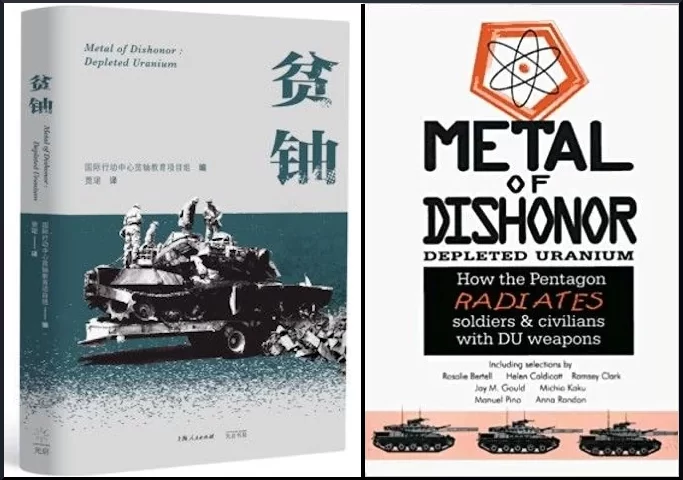by Janet Mayes, published on Workers World, June 15, 2023
As NATO forces resume using radioactive weapons, now shipping them to Ukraine, China has translated “Metal of Dishonor,” a groundbreaking book compiled 25 years ago by the International Action Center warning of the devastating consequences of deploying depleted uranium (DU) munitions.
The danger of these weapons spreading radioactive material was raised at a White House press briefing last winter, as reported by The Intercept, and callously dismissed by the U.S. spokesperson. (Jan. 26)
The IAC thanks the Chinese translator, Associate Professor Jia Jun of the Center for Modern World History, School of History, Beijing Normal University and Luminaire Books, a division of Shanghai Century Publishing Co., Ltd. for this timely contribution.
Global campaign to ban DU weapons
Significantly, “Metal of Dishonor,” published in 1997 and reissued in 1999, played an important role in gathering a great deal of the suppressed information on the devastating impact of DU’s low-level radiation. The book, its study guide and documentary, “Poison DUst,” were part of an international campaign to ban DU weapons.
The statement calling for the ban on the use of these weapons had tens of thousands of signers. It was translated into many languages and demonstrated the powerful campaign of antiwar forces exposing the impact of the use of these horrific weapons by Washington in the U.S. 1991 war in Iraq and the 1999 U.S./ NATO war to break up Yugoslavia.
The book is an alarming exposé of the dangers of the Pentagon’s DU weapons; it issued a dire warning about their devastating effects on soldiers and civilians. In it, scientists, Gulf War veterans, and leaders of environmental, anti-nuclear, anti-military and community movements discuss the connection of DU to Gulf War Syndrome and the then-new generation of radioactive conventional weapons.
Among the book’s contributors are Helen Caldicott, Michio Kaku, Jay M. Gould, Ramsey Clark and IAC Co-director Sara Flounders. “Metal of Dishonor” was coedited by Flounders and Workers World Managing Editor, John Catalinotto. A study guide accompanying the book and video was produced by Jim Wallace and Lyn Neeley.
Chinese edition echoes call for DU’s abolition
The preface to the Chinese edition warns:
“Depleted uranium weapons are not only harmful to their targets, but also harmful to the soldiers who operate the weapons, civilians around depleted uranium — and even their descendants. It caused bodily harm and threatened the future natural environment” [in countries where it was used].
“At the same time, this book calls for the joint boycott and abolition of depleted uranium weapons and the realization of interactive exchanges and peaceful coexistence on a global scale.”
DU explodes in Ukraine warehouse
In response to an explosion of British-supplied depleted uranium in a warehouse in Ukraine, which caused a radioactive cloud to head toward Western Europe, Dr. Chris Busby said in Sputnik International:
“DU must be banned. It is a weapon of indiscriminate effect and kills civilians, the enemy and your own troops [Ukrainian troops]. It is much worse than a war gas, like Sarin, or phosgene, mustard gas or all the other chemical agents banned by civilization.”
Busby stressed:
“This stuff destroys the genetic basis of life itself. And no one does anything. Those who use it base their action on obsolete science supported by dishonest epidemiology carried out by dishonest scientists and obsolete and fantastical risk models.” (May 19)
During the Iraq War, the U.S. use of radioactive DU weapons increased from 375 tons used in 1991 to 2,200 tons. Geiger counter readings at sites in downtown Baghdad recorded radiation levels 1,000 and 2,000 times higher than background radiation. The Pentagon bombed, occupied, tortured and contaminated Iraq. Millions of Iraqis were sickened.
Over 1 million U.S. soldiers were rotated into Iraq. The word “depleted” has a benign ring to it, but in 2005, half of the 697,000 U.S. Gulf War troops deployed in the 1991 war reported serious medical problems and a significant increase in birth defects among their newborn children.
The effects on the Iraqi population were far greater. Many other countries and U.S. communities near DU weapons plants, testing facilities, bases and arsenals were exposed to this radioactive material, which has a half-life of 4.4 billion years.
British official lies about DU’s dangers
British Foreign Secretary James Cleverly claims that the move to send DU munitions to Ukraine does not represent a nuclear escalation.
“It’s worth making sure everyone understands that just because the word uranium is in the title of depleted uranium munitions, they are not nuclear munitions; they are purely conventional munitions,” he said. (Reuters, March 23)
But Cleverly’s public-relations spin obscures the horrific truth comprehensively laid out in “Metal of Dishonor.”
‘Poison DUst’ film tells the truth
The documentary, “Poison DUst: A New Look at U.S. Radioactive Weapons,” was released in 2005 by the IAC/Peoples Video Network. It describes the effects of DU on the people it was used on — including the populations of Iraq, Vieques, Puerto Rico and Yugoslavia — as well as on the people who used it, the invading soldiers – and their families.
The film features Rosalie Bertell, Helen Caldicott, Ramsey Clark, Juan Gonzalez and Michio Kaku. It was produced, directed and edited by Sue Harris.
The deployment of DU munitions will boomerang. DU dust has no borders: It does not distinguish between combatants and civilians.
“Metal of Dishonor” and “Poison DUst” are as vital now as they were when they were first released. Activists need to be armed with every bit of information about DU weapons to further mobilize against U.S.-NATO provocation and expansion of the war in Ukraine, with these weapons destined to be used as well in other areas of the world, which are being or will be targeted by U.S. imperialism and its allies.
Order Metal of Dishonor: at tinyurl.com/2djethyr.
Check at IACenter.org on how to order the book directly from the IAC in the near future.
